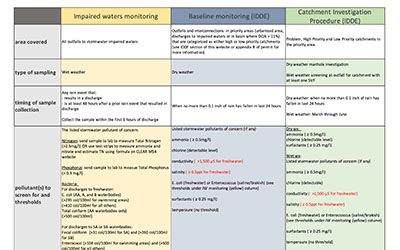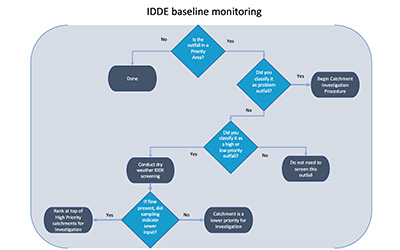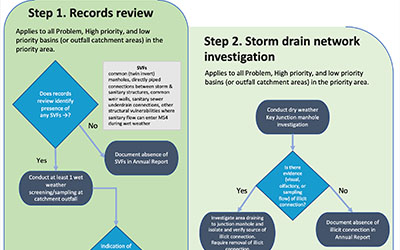Purpose
There are two parts of the permit that call for water quality monitoring. One requires wet weather monitoring of all outfalls that discharge directly to any stormwater impaired waters to determine what areas are contributing to the impairment. This requirement is detailed on pages 41-44 of the MS4 permit.
The other monitoring requirement is part of tracking down illicit discharges to the MS4 via the IDDE program. See pages 7-11 in Appendix B of the permit for details.
Quick Find:
Relevant Terms
Wet weather monitoring: means sampling an outfall during or after any rainfall event that results in a discharge from the outfall.
Dry weather monitoring: means sampling an outfall only when no more than 0.1 inches of rainfall has occurred in the previous 24 hours.
Stormwater impaired waters: means a subset of the surface waters of the state identified as impaired in the most recent Connecticut Integrated Water Quality Report as a result of stormwater runoff. See the MS4 Map Viewer for a map layer of CT's stormwater impaired waterbodies.
Catchment Area: means the area of land from which stormwater runoff is collected by a permittee’s MS4 and discharges through a single outfall to surface water.
Resources
Monitoring Requirement Comparison Sheet
This chart outlines the key elements of the two main monitoring requirements in the MS4 general permit: Impaired waters monitoring and IDDE monitoring. IDDE monitoring requirements are split into two sections: Baseline monitoring and the Catchment Investigation Procedure. Download the comparison sheet.
Impaired Waters Monitoring Factsheet
Monitoring of stormwater outfalls is required under the new MS4 permit, however the approach is slightly different than under the 2004 permit.
Now, all MS4 outfalls that discharge directly to stormwater impaired waters should be sampled at least once during the 5-year term of the permit. Visit our MS4 Map viewer to find out what waters in your town are impaired by stormwater. Note that all MS4 outfalls must be inventoried and mapped as part of the IDDE requirements but for this requirement, those outfalls that discharge to stormwater impaired waters must also be sampled for that impairement.
If you already have wet weather sampling data, it can be used to meet this requirement.
Key instructions:
- Only sample for the existing stormwater impairment(s) (e.g. nitrogen, phosphorus, bacteria). If impairment is 'Other pollutant of concern', sample for turbidity.
- Collect samples during any rain event that results in a discharge from the outfall.
- Complete drainage area investigations where screening indicates high pollutant levels (see table below) and implement BMPs to address the impairment. As an example, if a waterbody exceeds the nitrogen limit, target residents in the watershed for outreach on reducing nitrogen.
- Once half of all impaired waters outfalls have been sampled, select 6 of the highest polluting outfalls for annual screening.
| Pollutant of Concern | Screening Threshold |
|---|---|
| Nitrogen | Total nitrogen > 2.5 mg/l |
| Phosphorous | Total phosphorus > 0.3 mg/l |
| Bacteria | For discharges to Class AA, A, and B surface waters: - E. coli > 235 col/100ml for swimming waters and > 410 col/100ml for all others - Total coliform > 500 col/100mlFor discharges to Class SA and SB surface waters: - Fecal coliform > 31 col/100ml for Class SA and > 260 col/100ml for Class SB - Enterococci > 104 col/100ml for swimming areas and > 500 col/100ml for all others |
| Other Pollutant of Concern | Turbidity 5 NTU greater than instream sample just upstream of outfall |
Impaired Waters Monitoring Flowchart
IDDE Monitoring Factsheet
Before you begin the dry weather sampling requirements in the IDDE section, each MS4 must develop an inventory of all outfalls in priority areas, sort those outfalls into 4 categories (problem, high priority, low priority, excluded), and rank all the outfalls in each category based on specific characteristics. See the IDDE implementation section of this website or Appendix B of the permit for more details.
The IDDE section requires dry weather sampling of outfalls in priority areas that are classified as high or low priority (it does NOT need to be done for catchments in priority areas that are classified as problem or excluded outfalls). Dry and wet weather sampling is to be used as part of the follow-up investigations to help identify where an illicit discharge is coming from.
What to test for
All the dry and wet weather samples may be done with test kits or meters (except bacteria) and need to be analyzed for the constituents listed below. Proper sampling procedures need to be followed - for more information, there's a recording of the IDDE Dry weather screening and sampling presentation given at the IDDE workshop on the IDDE page. Also, see EPA's guide to proper sampling procedures.
- ammonia
- chlorine
- conductivity
- salinity
- E. coli. (freshwater) or enterococcus (saline or brackish receiving water)
- surfactants
- temperature
- Pollutant(s) identified as causing the impairment of the receiving water, if it is impaired*
*Note that no test kits exist for total nitrogen or total phosphorus - these samples will likely need to be sent to a laboratory.
Samples that exceed any of the following criteria shall be ranked at the top of the High Priority catchments for further investigation:
- Ammonia > 0.5 mg/L
- Surfactants > 0.25 mg/L
- Bacteria levels greater than the criteria applicable to the receiving water (see table on Impaired waters monitoring factsheet) OR detectable levels of chlorine.
IDDE Baseline Monitoring Flowchart
IDDE Catchment Investigation Flowchart
Fieldwork Checklist and Data Collection
Example spreadsheet for collecting required data during water quality sampling.
And an example fieldwork checklist used for water quality monitoring at the UConn Storrs campus.
Sampling Cost Estimates
Sampling Cost Estimates
We compiled example monitoring equipment that may be used to meet permit requirements and included costs for both in-house test kit/portable meter sampling vs. laboratory services. We've also created a map of the certified labs towns can use to analyze samples for bacteria, total N and total P.
NOTE: Bacteria sampling can’t be done in the field so requires lab services.
Test kit/Meter vs Lab Cost Estimates
| Pollutant | Test Kit / Meter | Price | Samples per kit | Cost per sample | Comments | Commercial lab cost per sample (estimate) |
|---|---|---|---|---|---|---|
| Ammonia | Hach N1-8 | $88 | 100 | $0.88 | Reagent for this kit contains mercury | $9.00 |
| Surfactants | Hach DE-2 | $307 | 32 | $9.59 | $16.00 | |
| Chlorine | Hach CN-66F | $55 | 100 | $0.55 | Sampling for either free chlorine or total chlorine is acceptable. DEEP is looking for detectable chlorine and the test kits or strips should have a lower detection limit of 0.1 mg/l or less. | $3.00 |
| Quantofix Chlorine test strips | $31 | 100 | $0.31 | |||
| Turbidity | Hach 2100Q | $1180 | n/a | TBD | ||
| LaMotte 2020we | $980 | n/a | ||||
| HF Scientific MicroTPW | $799 | n/a | ||||
| Nitrogen, Phosphorous | Lamotte Smart3 (Requires Heater Block for TN/TP) | $999 + $799 (heater block) = $1778 | $123 (TN) $89 (TP) | $4.90 (TN) $7.56 (TP) |
|
$8 (TP) $23 (TN) |
Stormwater Monitoring Equipment Loan Program
EPA: New England Stormwater Toolbox Equipment Loan Program
This EPA program supplies NGOs within New England with a loan of stormwater monitoring equipment. This equipment can then be distributed to any municipalities regulated by the MS4 for assistance in volunteer monitoring. The equipment includes water quality monitoring equipment such as a YSI, Colorimeter and Test strips to monitor WQ parameters, Chlorine, Ammonia, and Surfactants. The loan comes with initial supplies, but does not come with any replenishing or consumable supplies (gloves, reagents, etc). The program runs on a year long schedule with applications due in the Winter and toolboxes sent out in the Spring to be returned in the Fall.
There are 6 toolboxes for loan. The loan program is open to all NGO monitoring groups - groups subject to MS4 permit requirements are not eligible. Watershed associations are the most common applicants, but most non-governmental organizations are eligible. EPA typically verifies with the individual entity to determine eligibility if it comes into question. There is no limit to how many times a group can apply. A Quality Assurance Program or Project Plan must be submitted with the application.
For more information, reach out to coombs.michelle@epa.gov or download the loan program plan.
Task list
Most requirements for this section are in effect as of July 1, 2017 for all MS4s but more time is provided for the legal authority component.
Where the deadline for new MS4 permittees differs from the deadline for existing permittees, the second deadline in parenthesis applies to new permittees.
| Activity | Deadline | Permit Page |
|---|---|---|
| Impaired Waters Monitoring | ||
| Complete inventory of all outfalls that discharge to impaired waters | Jul 1 2019 (Jul 1 2020) |
43 |
| Begin screening outfalls to impaired waters | Jul 1 2018 (Jul 1 2019) |
44 |
| Complete screening 50% of outfalls to impaired waters | Jul 1 2020 (Jul 1 2021) |
44 |
| Complete screening all outfalls to impaired waters | Jul 1 2022 | 44 |
| Begin follow-up investigations where needed | Jul 1 2019 (Jul 1 2020) |
44 |
| Begin to monitor 6 'worst' outfalls annually | Jul 1 2020 (Jul 1 2021) |
44 |
| Activity | Deadline | Permit Page |
|---|---|---|
| IDDE Monitoring | ||
| Complete dry weather sampling (of all MS4 outfalls in High & Low priority catchments) | Jul 1 2020 (Jul 1 2022) |
Appendix B p.12 |
| Conduct wet weather sampling where required as part of Catchment Investigation Procedure | No specific deadline | Appendix B p.10 |
Monitoring Workshop Materials
The NEMO program presented a workshop on the CT MS4 water quality monitoring requirements on June 20, 2019 at Milford City Hall. Most of the presentations were recorded. The presentation slides and recordings (where available) can be found below.
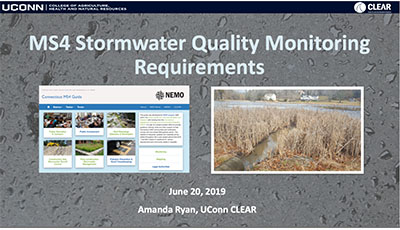
Overview of MS4 Monitoring Requirements
June 20th, 2019
Presented by: Amanda Ryan, UConn CLEAR
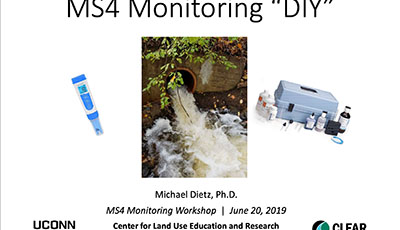
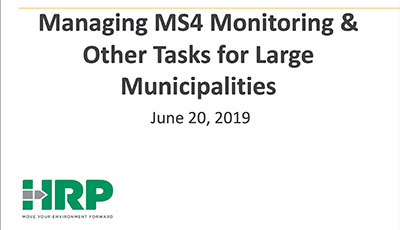
Managing MS4 Monitoring for Large Municipalities
June 20th, 2019
Presented by: Correne Auer, HRP Associates

Water Quality Monitoring Challenges and Data Management Solutions
June 20th, 2019
Presented by: Joseph Canas and Sarah Bounty, Tighe & Bond
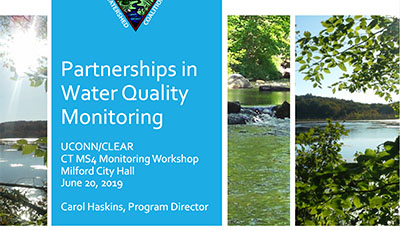
Partnerships in Water Quality Monitoring
June 20th, 2019
Presented by: Carol Haskins, Pomperaug River Watershed Coalition
